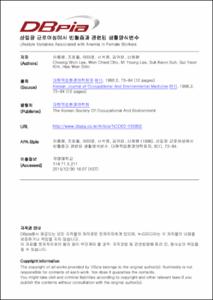KUMEL Repository
1. Journal Papers (연구논문)
1. School of Medicine (의과대학)
Dept. of Preventive Medicine (예방의학)
산업장 근로여성에서 빈혈증과 관련된 생활양식변수
- Keimyung Author(s)
- Lee, Choong Won; Lee, Mi Young; Suh, Suk Kwon
- Journal Title
- 대한산업의학회지
- Issued Date
- 1996
- Volume
- 8
- Issue
- 1
- Abstract
- The study was conducted from May to July in 1995 to investigate lifestyle variables associated with anemia in some female workers of the six large plants in Taegu. Cases were selected by a doctor based on symptoms and physical examination and controls were matched according to age limits(±5) and plant employed. The final subjects analyzed were 385 excluding 36 who had underlying diseases associated with anemia or many missing values. Anemia was defined by the blood hemoglobin level less than 12g/dL.
Anemic subjects were 190(49.4%) with nonsignificant age distribution between cases and controls. Univariate logistic regression showed that there was no statistically significant difference in sociodemographic and occupational variables. Number of pad used during menstruation (odds ratio, OR=1.03, 95% Confidence interval CI, 1.00-1.05) was the only significant among the menstruation-related variables. None of the lifestyle variables were significant but those who consume more than 4 cups of coffee a day vs. none and animal iron intake showed borderline statistical significance with the ORs 2.60 and 0.99, respectively. After controlling for marital status, native place and number of pad with the multiple logistic regression, those who consume more than 4 cups of coffee a day vs. none showed statistically significant OR 2.93(95% CI 1.01-8.49). Animal iron intake and diet to lose weight indicated borderline significance with ORs 0.99(p=0.06) and 1.47(p=0.09), respectively. These results suggest that there are some anemia-associated lifestyle variables and these variables may be important for the behavior modification to prevent anemia in female workers.
이 연구는 근로여성들의 빈혈증에 대한 원인중 식이를 포함한 생활양식변수와의 관련성을 밝혀내어 근로여성들을 대상으로 중재가능한 빈혈증 예방대책을 세우기위한 기초자료를 제공하고자 1995년 5월부터 7월까지 계명대학교 동산병원 건강관리과에서 특수 및 일반검진을 시행한 대구시 지역의 사업장 중 여성 근로자들이 많은 6개의 사업장을 대상으로 실시되었다. 빈혈증자는 의사가 문진과 진찰을 기초로 하여 선택하였으며 대조군은 동일한 사업장 근로자로서 빈혈증으로 의심되는 자의 나이에 ±5세 이내인 자로 선택하였다. 조사자 총 421명 중 자료가 미비한 자, 빈혈증을 유발시킬 수 있는 질병유소견자 등을 제외한 385명이 분석의 대상자가 되었다. 최종적으로 빈혈증은 혈색소가 12.0 g/dL 미만인 자로 정의하였다.
총 인원 385명중 빈혈증자는 190명으로 49.4%이었으며 연령의 분포는 정상자와 빈혈증자간에 유의한 차이가 없었다(p=0.81). 단일지수희귀분석에서 사회인구학적 및 직업적인 변수들은 빈혈증과 연관을 나타낸 변수는 없었으나 월경과 관련된 변수중에는 1회 월경시 소비하는 패드수가 유의한 관련성을 나타내었다(비차비 1.03, 95% 신뢰구간 1.00-1.05). 생활양식변수에서 통계적인 유의성을 나타낸 변수는 없었으나 경계선 유의성을 보인 변수는 커피 비소비자를 기준으로 하루에 4잔 이상 소비하는 자와 동물성 철섭취량으로써 비차비가 각각 2.60과 0.99이었다. 결혼상태, 출신지 및 패드수를 다중지수희귀분석으로 통제한 후 생활양식변수와의 빈혈증간의 관계에서 커피 비소비자를 기준으로 하루에 4잔 이상 소비하는 사람의 비차비가 2.93(95% 신뢰 구간 1.01-8.49)으로 단일변수분석에 비해 약간 증가하면서 통계적인 유의성을 나타내었다. 동물성 철섭취와 체중을 줄이기위한 다이어트가 경계선 유의성을 나타내었으며 비차비는 각각 0.99(p=0.06)와 1.47(p=0.09)이었다. 이러한 결과는 근로 여성에서 빈혈증과 관련된 생활양식변수가 존재하며 이들 변수들은 빈혈증 예방을 위해 중재가 가능한 변수로서 중요함을 시사해준다.
- Alternative Title
- Lifestyle Variables Associated with Anemia in Female Workers
- Publisher
- School of Medicine
- Citation
- 이충원 et al. (1996). 산업장 근로여성에서 빈혈증과 관련된 생활양식변수. 대한산업의학회지, 8(1), 73–84.
- Type
- Article
- ISSN
- 1225-3618
- 파일 목록
-
-
Download
 oak-bbb-1717.pdf
기타 데이터 / 1.29 MB / Adobe PDF
oak-bbb-1717.pdf
기타 데이터 / 1.29 MB / Adobe PDF
-
Items in Repository are protected by copyright, with all rights reserved, unless otherwise indicated.